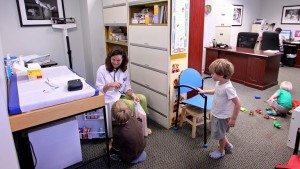The pediatrician’s office is becoming a new player in helping children learn foundational skills for communication, language development, and eventually reading.
 But a project in New York is taking this concept a step further, by bringing digital technology—specifically, video cameras and video players—into the doctor’s office.
But a project in New York is taking this concept a step further, by bringing digital technology—specifically, video cameras and video players—into the doctor’s office.
The Video Interaction Project (VIP) is underway at the Langone Medical Center at New York University. Specialists meet with parents and caregivers during regular well-check visits and record them playing with or reading to their young children.
These meetings occur 15 times, usually on the same day of primary care visits between a child’s birth and 5-year-old birthday, either before or after the child and parent have their regular appointment with the pediatrician.

The specialists spend about 30 to 45 minutes with families, helping parents to see how they can interact with children in pretend play, guided reading or other learning activities. They create a 5 to 7 minute video of the parent (or other caregiver) playing with her child during that time. And then to provide better understanding and guidance, the specialists watch the video with parents to highlight achievements and to discuss areas for improvement. Parents get a copy of the video to take home and share.
The goal, said Alan Mendelsohn, a pediatrician who started the project in 1999 and is studying its effects, is to encourage critical interactions between parents and children through playing or reading together and to make parents more self-reflective. “They themselves can begin to say ‘wow this is really cool what I did.’ Or ‘that would have been an opportunity to engage with my child,’” he said.
With nine years of funding from the National Institutes of Health, researchers have been following participants since 2005, and so far they’ve been pleased by the results. They’ve conducted a half-dozen or more studies with participating families, including at least three randomized control studies, the “gold standard” of research.
The participating mothers were low-income Latina immigrants with a tenth-grade education, on average—in other words, parents whose children are often at risk for struggles in school. The researchers used various assessment tools to measure children’s cognitive skills and other effects, and parents also kept a reading-recall diary of their interactions.
In one study, 410 parents were divided into three groups: one took part in the VIP program, another received a newsletter with information on child development, and the third was a control group with no intervention.
The results showed that children in the VIP group had higher scores on cognitive tests at six months and parents and children did more reading activities compared with the control group. The greatest effects were for mothers with a ninth-grade or higher reading level. Kids were exposed to less television watching as well, in part because of the enhanced parent-child interactions.
In a second randomized control study with 99 Latino children and their mothers, the program modestly boosted cognitive development for toddlers at 33 months, and the children were less likely to have developmental delays. The cognitive boost had been apparent at 21 months as well.
Mendelsohn said these findings are important as evidence that the doctor’s office is an underused resource in the fight to catch low-income children up to their more advantaged peers. He’s been studying poverty related disparities and school readiness for many years, and recognizes that babies begin learning as soon as they’re born, most crucially through their interactions with the adults in their lives.
“We need to intervene earlier,” he told News 12 Brooklyn last year, “if we are going to reduce the gaps in school performance that happen for low-income families.”
Outside of VIP, other examples are also emerging of doctors getting involved. A large-scale example is Reach Out and Read, a literacy program started in the early 1990s trains doctors and nurses to talk with parents about the importance of reading and provides new books to patients at regular well-check appointments.
It is a “a rich and engaging opportunity to provide similar guidance around literacy,” said Mendelsohn, who was also involved in Reach Out and Read studies.
And it works, according to several research studies done in the early 2000’s. Families who take part in Reach Out and Read are more likely to have books in the home and to read to their children. The program is also associated with strides in vocabulary among older toddlers. It now operates at 5,000 medical sites throughout the United States, including at Bellevue Hospital where Mendelsohn works, and touches almost four million children, most of whom are from low-income families.
The American Academy of Pediatrics has traditionally cautioned against technology use with young children—they recommend no screen time for kids under age two. But Mendelsohn, who’s a member of the American Academy of Pediatrics Council on Early Childhood, sees promise in ways to use technology to help enhance interaction between parents and their children instead of distracting from it.
The project has expanded beyond the research setting to Woodhull Medical Center in Brooklyn. We’ll be taking a closer look at this work as as part of the research for Seeding Reading, a series of blog posts at EdCentral.org and the Joan Ganz Cooney Center’s blog, on of the role technology plays in early literacy. Stay tuned.
The Video Interaction Project has expanded beyond the research setting to Woodhull Medical Center in Brooklyn. We’ll be taking a closer look at this work as as part of the research for Seeding Reading, a series of blog posts at EdCentral.org and the Joan Ganz Cooney Center’s blog, on the role technology plays in early literacy. Stay tuned.


